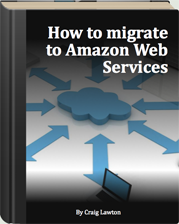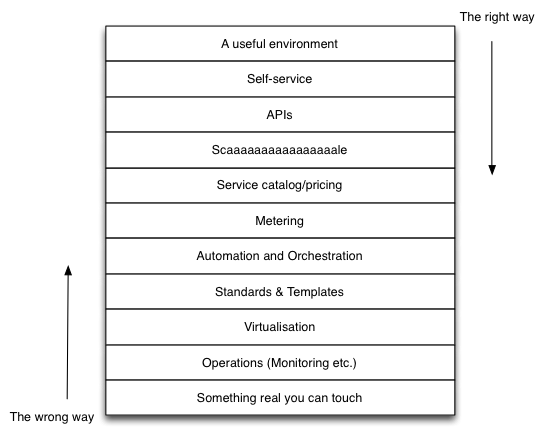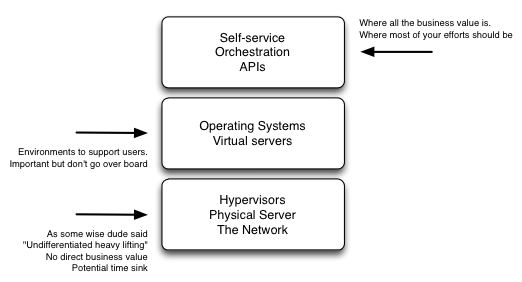In parts 1-4 of this blog series we explored some reasons why private clouds bombed. In this final blog, I’d like to discuss a better approach
Finding examples of successful private clouds is difficult because many organisations claim to have a private cloud when in fact all they have done is install VMware. If a project manager has to organise a resource to install something it’s not a cloud. Cloud is not virtualisation.
If you were starting a private cloud environment build 3 years ago, it would look different to one you would begin building now. But I like to live in the here and now so let’s look at what we would do now.
For starters, reverse these unspoken principles:
- IT departments do
notneed to communicate with their users. - IT departments are
needed and irreplaceable. - Users
don’tknow their needsand IT departments do.
Then approach as shown below. Users care about the items closer to the top.
Now, look at your best use-cases and choose a champion project/platform/department to partner with so you can create one end-to-end service.
Then get the right people on board to build it out. The guy who built your virtualisation stack back in the naughties probably doesn’t have the social intelligence (and hygiene) to approach users and “communicate”. Users value the speed in which resources can be allocated to them, the simplicity of getting their work done and the lack of friction involved so put someone in charge who understands public clouds, understands service design and delivery and is willing to start with an open mind. Then create a list of services you wish to offer.
Eventually after much work and discussion you’ll get to the point where you understand the services you want and what is required of the technology to support your cloud. This is where you may get derailed. Whatever happens make sure your choices minimise “tinkering”, promote scalability through modularity, and can work with your current network.
Your network may suck. It may make providing access to external and internal users difficult. It may be impossible to converge data and storage networks. If so, you could wait for SDN to mature and your CIO to give you budget for a Network Refresh or…
- You could build the cloud off-premises. Private cloud is used only by internal users but can be built anywhere. So build it in Rackspace or AWS, or a local provider if data sovereignty is an issue.
- You could build the cloud on converged infrastructure which includes its own networking. Something like vBlock or FlexPod. Converged Infrastructure is modular, making it easy to add and manage computing power, storage or networking throughput. The seamless coordination between hardware manufacturer (compute, storage and networking) and virtualisation is key to private cloud computing. It resists “tinkering”.
You’ll need more tools over time to manage this because of new standards and platforms, capacity-managing a pool of resource aggregated at a data-centre level, and also in planning for the hybrid cloud (which may exist for real one day). But all in good time.
The cloud is essentially a vending machine. It’s an automation-oriented, self-service approach to IT. Anything else is folly.








